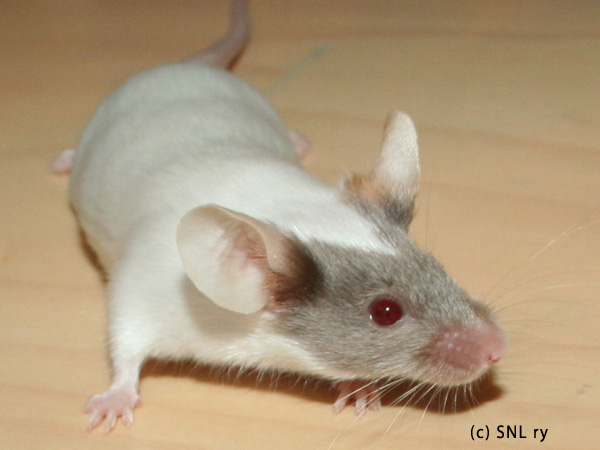Varieties
Marked
Capped (*/ca)
Wbd/Wsh
"The colour not to extend past the ears and to follow the line of the lower jaw bone, it should not extend under the chin. There should be a white line or an open star in the face and the rest of the body white. Colour as in any standardized variety. Eyes as in the standardized variety."
Breeding information below the pictures.
Quick Look
Capped is variety that popped up in my mousery out of banded lines, though most likely through a pet shop found mouse. Shortly after I "came out" with the variety, same kind of mice were found in pet shop and later other mouseries tried their hands with them. Capped was welcomed as a beautiful and sufficiently different variety among the marked mouse varieties. This variety looks a lot like the rat variety capped, from which the standard and the name is derived.
Capped got full standard in late 1997.
Genetic Background
The genetic make-up was unknown for a while, although it was well known it was related to banded and wasn't simply "double-banded". However, aenemia of some capped young - homotsygous ones with little markings - and descriptions on geneticists' sites have led me to believe that capped is genetically Wbd/Wsh - with Wbd being a gene called "banded" and Wsh being the banded-variety gene called "sash".
Capped is what you get with Wbd/Wsh, homozygous Wbd/Wbd are very lightly patterned or (more usually) practically white mice and are not likely to survive into 8 weeks of age. More on this later. In heterozygous form, Wbd/+ makes banded, but with usually very wide band. Wsh/+ is your common banded and Wsh/Wsh is "charlie", which is a double-wide banded. Sometimes charliers look like a capped, but I haven't yet seen a charlie that would fit the capped standard the way Wbd/Wsh young. Charlies tend to have colour on their rumps and their head markings wrong.
Wbd is a semidominant and like the whole of w-locus, is located in chromosome 5. Via linkage, this affect what else the mouse can be besides capped. Other qualities reciding in the same choromosome are either linked with Wbd, or can be introduced only through re-linkage.
In More Practical Terms...
In practice, the most useful combinations are:
- Wbd/Wsh + Wsh/+, capped x banded. This gives both capped (Wbd/Wsh), banded with banded gene (Wbd/+) and so called true banded with sash (Wsh/+).
- Wbd/Wsh x Wbd/Wsh, capped x capped. This gives both capped (Wbd/Wsh) and charlies (Wsh/Wsh). Especially in longer-running capped lines these charlies can look almost like cappeds, but in practice they are always more heavily marked. They can be told apart from Wbd/Wsh cappeds in that they are completely healthy as babies.
Banded gene Wbd together with sash Wsh and especially in homozygous form make the young aenemic. The young go through a phase when they have a phase of "stick leg-greasy coat" around the ages of 3-5 weeks. At this phase, the young have pale and "stick-like" legs and tail, very pale ears, round belly and very greasy looking coat. Symptoms of megacolon have also been spotted. Some young, especially those with least colouring, won't survive, but those who do grow up to be completely normal, healthy adults.
There have been some experiments made and these have included rumpwhite to capped matings. These have produced everything from capped to rumpwhite, meaning that every amount of white inbetween was produced - even "bareback" mice. When one of these mice was mated with a capped related banded, there were rumpwhites in the resulting litter, as rumpwhite's own markings got "hidden" in the extensive white markings.
Common faults on cappeds include the colouring spreading too far behind the ears and/or below the jaw line. The tail can also sport coloured spots (not seen on pink-eyed varieties).
Starting From Scratch?
In order to breed cappeds, you will need a true capped, or a Wbd/+ banded. The latter can't really be told apart from Wsh/+ bandeds before you breed from them and start getting greasy coated capped youngsters hopping around with one size too large pale legs.







